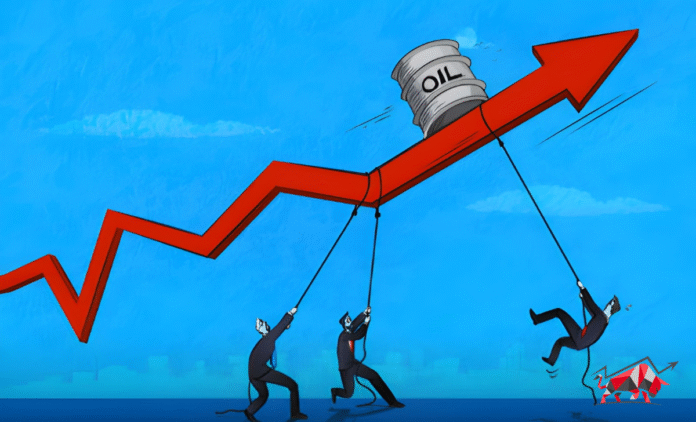Oil prices sharply increased on Friday following significant air strikes by Israel on Iran, sparking fears of potential supply disruptions across the region and triggering investor demand for safe-haven assets.
Israel’s Strikes Hit Iranian Nuclear Sites and Military Facilities
Late Thursday, Israel launched powerful air strikes targeting Iran’s nuclear installations and key military sites. Iranian officials confirmed the deaths of two senior commanders, although they maintained that no oil facilities were damaged. This marked an unprecedented escalation in the long-standing tensions between the two nations.
Michael Alfaro, chief investment officer at hedge fund Gallo Partners, described the attack as a “seismic escalation” in the conflict. In his view, this move significantly raises the risk of a protracted confrontation, pushing oil prices higher in the medium to long term.
By Friday afternoon, Brent crude—the global benchmark—had surged 6.5 per cent, reaching $73.89 a barrel after briefly climbing more than 12 per cent. US benchmark West Texas Intermediate also rallied, up 6.6 per cent, trading at around $72.51 per barrel. This surge reflects growing concerns over potential disruptions in oil supply stemming from renewed hostilities in the region.
The strike sent ripples through global financial markets. The S&P 500 dropped 0.9 per cent, while investors flocked to gold—a traditional safe-haven asset—driving its price up 1.4 per cent to $1,432 per troy ounce. This move highlights how geopolitical shocks can swiftly shift investor sentiment toward security and stability.
Heightened Risks for Oil Transit Routes
A major concern is the Strait of Hormuz, a narrow waterway that carries roughly one-third of the world’s seaborne oil supplies. Iran has repeatedly warned it may close the strait in retaliation for attacks, which would significantly curtail global oil shipments and further drive price volatility.
Read More: Frontline Avoid Strait of Hormuz Amid Middle East Tensions
Moreover, some of the world’s largest oil fields—located in Saudi Arabia and Iraq—are within reach of Iran’s military capabilities, including drones and missiles. In 2019, Iran was widely suspected of orchestrating an attack on Saudi oil facilities—a factor that sparked a sharp, though brief, spike in oil prices.
This crisis does not bode well for the global liquefied natural gas (LNG) market either. Qatar, one of the world’s major LNG exporters, relies on transit through the Strait of Hormuz to move its shipments. With global demand already tight, any additional pressure on supply routes could lead to a surge in overall energy costs.
Will Iran Retaliate Against Energy Infrastructure?
Analysts are now pondering whether this is simply a military engagement or if Iran will expand its response to include regional energy targets. Helima Croft, a former CIA analyst at RBC Capital Markets, stressed that the crucial question is whether Iran intends to “internationalise the cost of tonight’s action by targeting regional energy infrastructure.” Such a move could exacerbate supply risks and deepen market turbulence.
US Strategic Petroleum Reserve Could Come into Play
A high price environment would likely prompt the United States to once again tap into its Strategic Petroleum Reserve (SPR), which currently holds around 400 million barrels—significantly below its peak of roughly 727 million. During the 2022 oil crisis triggered by Russia’s invasion of Ukraine, the Biden administration released more than 300 million barrels from the reserve to stabilise prices.
Interestingly, President Donald Trump has indicated he would also use the SPR to mitigate price spikes, despite accusing the Biden administration of depleting it. Trump previously emphasised that keeping oil prices low should remain a priority to support broader economic stability.
A Tense Turning Point for Energy Markets
The recent air strikes mark a volatile turning point for both geopolitical and energy markets. The immediate surge in oil prices is a clear signal that investors view the Middle East as once again a flashpoint for supply disruption. With both crude oil and LNG flows potentially threatened, global economic growth could face new headwinds if the conflict deepens.
While the US may find some relief by releasing crude from its SPR, this is a temporary fix. Sustained upward pressure on oil and gas prices could accelerate inflation globally, forcing central banks to reassess their policy stances. The risk is clear: higher energy costs could dampen post-pandemic recovery, straining households and businesses alike.
The pivotal question is whether Iran’s response remains limited or escalates to broader regional engagement. If Tehran targets energy infrastructure in Saudi Arabia, the UAE, or even Qatar, the result could be a dramatic reshaping of global energy flows. Such a scenario would push crude prices beyond the $80‑$90 range, compel emergency strategies from oil-consuming nations, and intensify inflationary risks.
In sum, this moment demands close monitoring. Markets should prepare for sustained volatility. The real test will be whether diplomacy or further military escalation dictates the next move.


